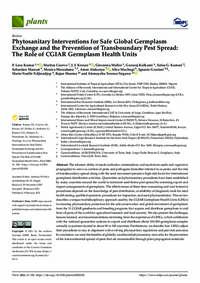Phytosanitary Interventions for Safe Global Germplasm Exchange and the Prevention of Transboundary Pest Spread: The Role of CGIAR Germplasm Health Units

Authors:
The inherent ability of seeds (orthodox, intermediate, and recalcitrant seeds and vegetative
propagules) to serve as carriers of pests and pathogens (hereafter referred to as pests) and the risk
of transboundary spread along with the seed movement present a high-risk factor for international
germplasm distribution activities. Quarantine and phytosanitary procedures have been established
by many countries around the world to minimize seed-borne pest spread by screening export and
import consignments of germplasm. The effectiveness of these time-consuming and cost-intensive
procedures depends on the knowledge of pest distribution, availability of diagnostic tools for seed
health testing, qualified operators, procedures for inspection, and seed phytosanitation. This review
describes a unique multidisciplinary approach used by the CGIAR Germplasm Health Units (GHUs)
in ensuring phytosanitary protection for the safe conservation and global movement of germplasm
from the 11 CGIAR genebanks and breeding programs that acquire and distribute germplasm to and
from all parts of the world for agricultural research and food security. We also present the challenges,
lessons learned, and recommendations stemming from the experience of GHUs, which collaborate
with the national quarantine systems to export and distribute about 100,000 germplasm samples
annually to partners located in about 90 to 100 countries. Furthermore, we describe how GHUs adjust
their procedures to stay in alignment with evolving phytosanitary regulations and pest risk scenarios.
In conclusion, we state the benefits of globally coordinated phytosanitary networks for the prevention
of the intercontinental spread of pests that are transmissible through plant propagation materials.
